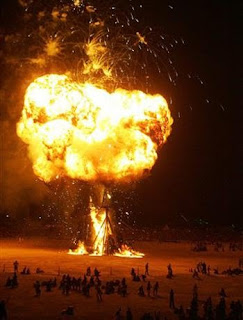The Burning Buddha asks us to contemplate human rights and those who have given their lives to bring abuses to our attention. It symbolizes hope standing as a beacon for the sanctity of life and the value of belief. The intentional-art activist and sculptor Blake (parental guidance advised) has created a bronze figure, the central image in a multimedia installation. The artist aims to raise awareness, dialogue, and a positive response on social issues.


How is this Enlightening?
Wisdom Quarterly (OPINION)
This is not the first time fire has been used to make a statement. Self-immolation shook the world when iconic images circulated showing a Mahayana Buddhist monk (Thích Quảng Đức) poignantly protesting the treatment of Buddhists in South Vietnam. And annually the Burning Man festival erects and sets aflame a large wooden figure in another example of activism.
But the question comes up, How could any of this be considered enlightening? The connection may be to a stirring sermon the Buddha once delivered to ascetics dwelling in the forest tending to and venerating the sacred fire. The Buddha set out to enlighten them by pointing out what was really burning. So successful was he that he repeated what came to be known as the Fire Sermon.
The Fire Sermon
Ñanamoli Thera, edited by Wisdom Quarterly (Adittapariyaya Sutra, SN 35.28)
Thus have I heard. On one occasion the Buddha was living in the Gaya district, at Gayasisa, together with a thousand Buddhist monks (bhikkhus). There he addressed them:
"Bhikkhus, all is burning! And what is the all that is burning?
"The eye is burning, visible forms are burning, eye-consciousness is burning, eye-contact is burning, and whatever is felt as pleasant or painful or neither-painful-nor-pleasant which arises with eye-contact as its indispensable condition, that too is burning!
"Burning with what? Burning with the fire of lust, with the fire of hate, with the fire of delusion. I declare it is burning with birth [origination], aging [decay], and death [cessation], with sorrow, with lamentation, with pain, with grief, with despair.
"The ear is burning, sounds are burning...
"The nose is burning, odors are burning...
"The tongue is burning, flavors are burning...
"The body is burning, tangibles are burning...
"The mind is burning, ideas are burning, mind-consciousness is burning, mind-contact is burning, and whatever is felt as pleasant or painful or neither-painful-nor-pleasant which arises with mind-contact as its indispensable condition, that too is burning!
"Burning with what? Burning with the fire of lust, with the fire of hate, with the fire of delusion. I declare it is burning with birth, aging, and death, with sorrow, with lamentation, with pain, with grief, with despair [or in a single word, with dukkha].
"Bhikkhus, when a noble follower who has heard (the truth) sees thus, that person finds estrangement [disenchantment] in the eye, finds estrangement in visible forms, finds estrangement in eye-consciousness, finds estrangement in eye-contact, and whatever is felt as pleasant or painful or neither-painful- nor-pleasant that arises with eye-contact as its indispensable condition, in that too one finds estrangement.
"One finds estrangement in the ear... in sounds...
"One finds estrangement in the nose... in odors...
"One finds estrangement in the tongue... in flavors...
"One finds estrangement in the body... in tangibles...
"One finds estrangement in the mind, finds estrangement in ideas, finds estrangement in mind-consciousness, finds estrangement in mind-contact, and whatever is felt as pleasant or painful or neither-painful-nor-pleasant that arises with mind-contact as its indispensable condition, in that too one finds estrangement.
"When one finds estrangement, passion fades away. With the fading of passion, one is liberated. When liberated, there arises knowledge that one is liberated. One understands: 'Birth is exhausted, the holy life has been lived out, what can be done has been done, of this there is no more beyond.'"
That is what the Blessed One said, and the bhikkhus being glad approved of his words.
Now during this utterance, the hearts [synonymous with minds] of those thousand bhikkhus were liberated from the taints* through clinging no more, and they became enlightened.
IN DEPTH: Liberation from "Taints"
Buddhist Dictionary and Glossary of Buddhist Terms
 Taint (āsava): something that obstructs progress toward enlightenment. The Abhidharma lists four taints: sense desire, craving for eternal existence, (wrong) views, and ignorance.
Taint (āsava): something that obstructs progress toward enlightenment. The Abhidharma lists four taints: sense desire, craving for eternal existence, (wrong) views, and ignorance.
The discourses usually list only three, omitting explicit mention of the taint of views although it is referred to implicitly (e.g., at Middle Length Discourses 2).
In the Khuddakavatthu Vibhanga both the threefold and fourfold division are mentioned. The fourfold division also occurs under the name of "floods" (ogha) and "yokes" (yoga).
The taints fall away through the stages of enlightenment: Through stream-entry, the taint of views is destroyed; through non-returning, the taint of sense-desire; through full enlightenment, the taints of existence and ignorance.
MN 2 shows how to overcome the taints, namely, through insight, sense-control, avoidance, wise use of life's necessities, and so on.
Khīṇāsava, "one whose taints are destroyed" or "one who is taint-free," is a name for the arhat or fully enlightened person. This state is frequently called āsavakkhaya ("the destruction of the taints").
Discourses concluding with the attainment of enlightenment by those in the audience often end with the words: "During this utterance, the hearts of the bhikkhus were freed from the taints through clinging no more" (anupādāya āsavehi cittāni vimucciṃsūti).


































































































































































































































No comments:
Post a Comment